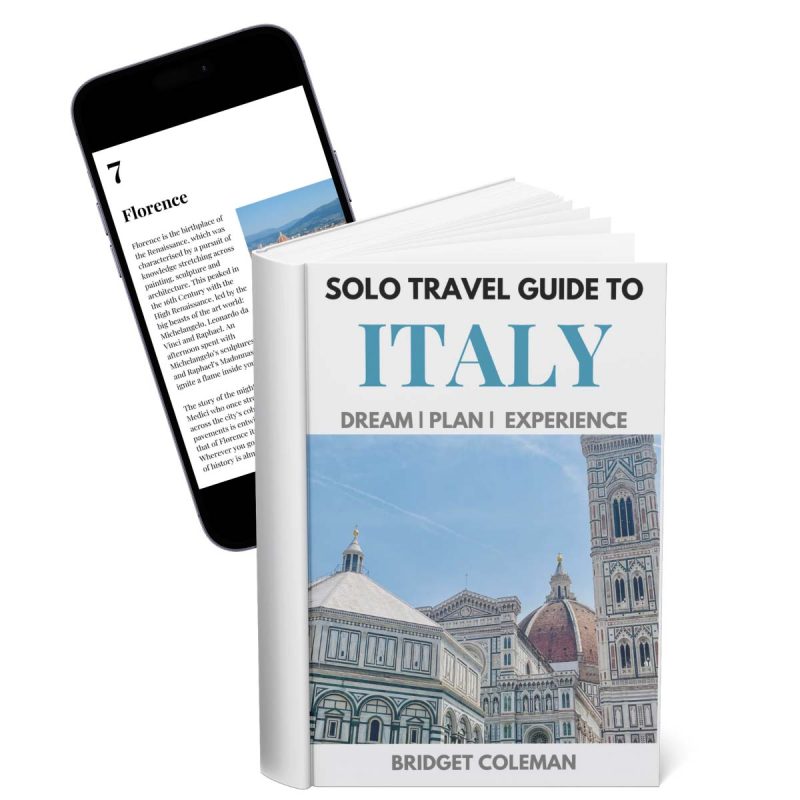I fell head over heels with Florence as a wide-eyed 20-something solo traveller on her first big trip to Europe. During the next thirty years, that passion was rekindled over more repeat visits than I can count.
Walk in the footsteps of Michelangelo and the Medici with my 3-day Florence itinerary. As well as including my favourite things to do in the Cradle of the Renaissance, I’ve included all the tips and practical information you need to make your visit unforgettable.

Some articles on this website contain affiliate links. This means that I may earn a small commission if you make a purchase through these links. As an Amazon Associate, I earn from qualifying purchases. Read the full disclosure here.
How to Spend 3 Days in Florence
Florence is endlessly captivating.
By day you can immerse yourself in art and history; at night you’ll be wowed by the food and wine served at its restaurants (not forgetting gelato and the best coffee in the world). If you crave other historic towns or want to sip Chianti in the rolling Tuscan countryside, Florence is an excellent base for adventures by road or rail.
Three days in Florence is enough time to visit its main sights, provided you plan what to do in advance. But this endlessly fascinating city has so much to offer, and you will need to accept that you will not be able to do it all in a weekend (and neither should you try).
With that in mind, my itinerary is designed to allow you to see Florence’s major attractions and soak up its culture and history without running yourself ragged in the process. After all, you are on holiday.
I’ve had three decades to put together something that works and this is how it shapes up:
- DAY 1: Tracing the Renaissance (Duomo Complex, Piazza Signoria, Uffizi Galleries and Ponte Vecchio)
- DAY 2: Michelangelo and the Medici (San Marco, Galleria Accademia, Bargello Museum and Santa Croce)
- Day 3: Timeless views in the Oltrarno (Brancacci Chapel, Pitti Place, Boboli Gardens, Piazzale Michelangelo, Rose Garden and San Miniato)
I’VE WRITTEN THIS ITALY SOLO TRAVEL GUIDE!
A 100+ page ebook to inspire and equip solo travellers with the confidence and knowledge to explore Italy independently
- Plan Your Trip – with curated itineraries, budgeting and how to get around
- Explore Awesome Destinations – guides to the must-see cities of Rome, Florence, Venice and Naples
- Stay Safe as a Solo Traveller – practical safety advice, empowering you to confidently navigate Italy and avoid common pitfalls
- Enjoy Eating Out in Italy – essential tried-and-tested solo dining tips
My Top Florence Tips
Visit Florence from March to May, or from September to late October
Two factors will impact your visit for better or worse: the crowds and the weather.
The peak season in Florence is from late May to the end of August. Expect places to be much busier and prices of accommodation higher.
Temperatures build from the end of May, peaking in August. Give August a wide berth at all costs. November and December can be wet, and January and February are cold.
I have been in Florence when it was scorchio and when it was raining stair-rods. Neither was much fun.
Buy your tickets in advance
For good reasons, visitors to Florence make a beeline for the Duomo, Uffizi Galleries and the Accademia. To avoid standing in long queues – or, worse still, not getting in – book tickets for these attractions before you arrive in the city.
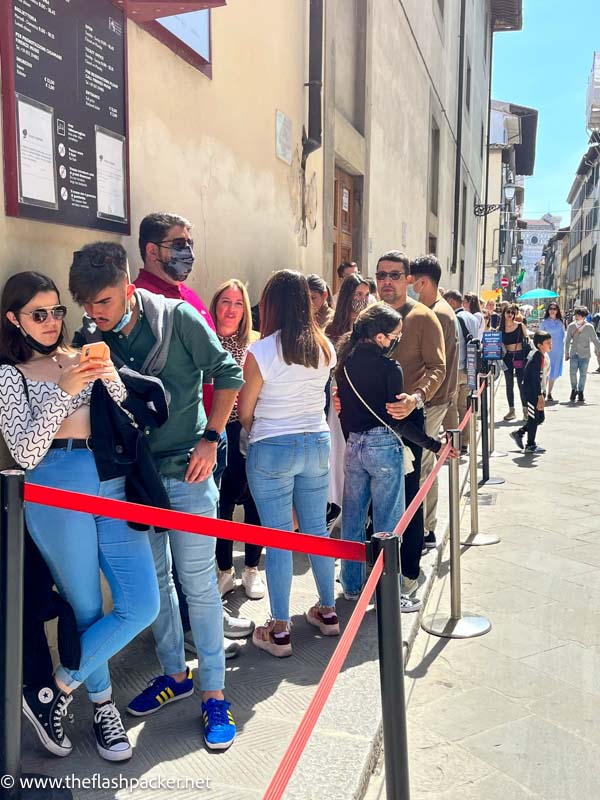
Check opening hours carefully
The opening hours of some of Florence’s churches, museums and galleries verge on the Byzantine. I have been caught out on more than one occasion. Check these carefully before visiting, at the attraction itself or the Tourist Information Office (there’s a handy one at Piazza del Duomo). Opening hours are also subject to sudden change and the times on websites do not always reflect reality.
Dress modestly when visiting Florence’s churches
Always respect worshippers, even when Mass isn’t in progress, and never use flash.
Build in loo breaks
Toilets are scarce in Florence and public loos typically charge up to €1 to spend a penny. Make good use of toilets in bars, restaurants and museums.
Pace yourself
Finally, don’t overdo it. Build several breaks into your Florence sightseeing to allow you to cool off and grab a gelato or water.
Equally importantly, this will make you pause and reflect on what you have just seen.
My Suggested 3-Day Florence Itinerary
My hand-crafted itinerary aims to ensure that you see the best of Florence in three days. I have created it to make your visit as time-efficient as possible and to tell the rich story of the city through its attractions.
If you find it helpful to map things out, here’s one I prepared earlier, colour-coded by day. For an interactive map, click here or on the image.
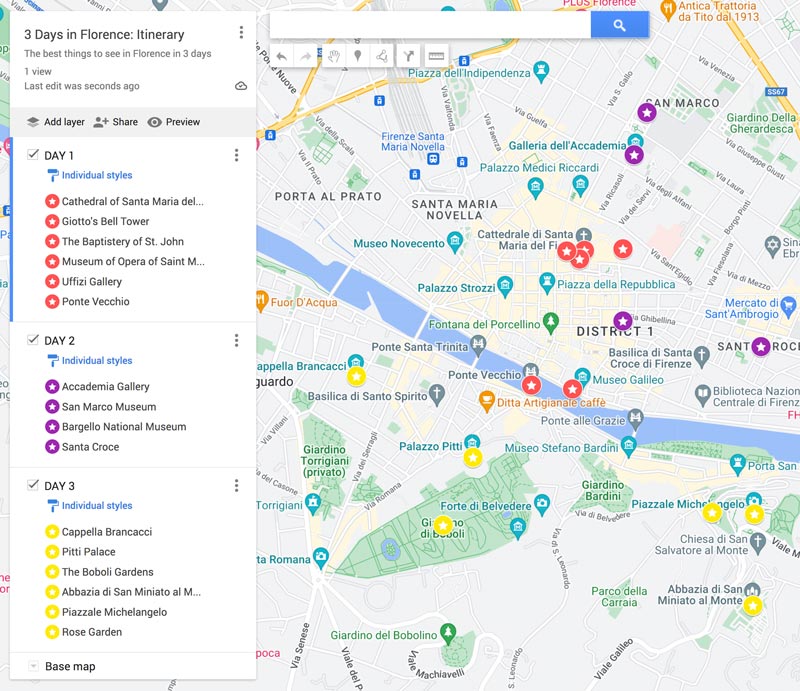
DAY 1: Tracing the Renaissance (Duomo Complex, Uffizi Galleries and Ponte Vecchio)
Florence is the cradle of the Renaissance.
The Renaissance was characterised by a dedicated pursuit of knowledge spanning painting, sculpture and architecture. At a time when much of Europe was mired in medievalism, Florence was booming, thanks to its bankers and trade merchants.
It peaked in the 16th Century with the High Renaissance, led by the big three: Leonardo da Vinci, Raphael and Michelangelo.
DUOMO COMPLEX
The area around the Duomo is Ground Zero of the Italian Renaissance and is where you will find Florence’s most recognisable landmarks.
The Duomo complex comprises the Duomo (Florence Cathedral), the Duomo Museum, Giotto’s bell tower and the Baptistery.
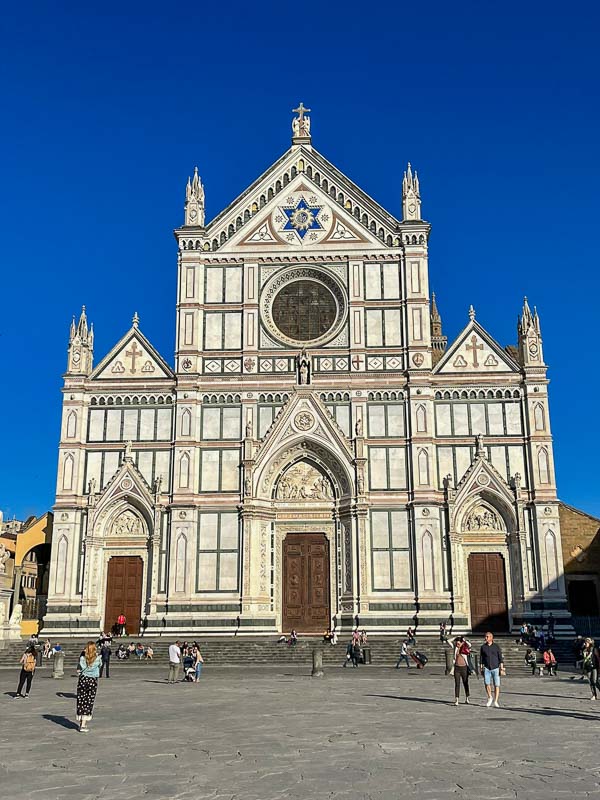
Buying tickets for the Duomo complex
With the exception of the cathedral itself, you need a ticket to enter any of the structures of the Duomo complex. However, you are not able to buy individual tickets. Instead, three combination tickets are on offer in 2024, all of which are valid for three calendar days.
Brunelleschi Pass
For dome climbers
- Duomo Museum
- Baptistery of St. John
- Santa Reparata
- Giotto’s Bell Tower
- Brunelleschi’s Dome
Giotto Pass
To scale Giotto’s Tower
- Duomo Museum
- Baptistery of St. John
- Santa Reparata
- Giotto’s Bell Tower
Ghiberti Pass
For history buffs
- Duomo Museum
- Baptistery of St. John
- Santa Reparata
I recommend climbing either Brunelleschi’s dome or Giotto’s Tower for their unforgettable views of Florence. Of course, you can scale both but they are strenuous climbs.
Climbing Brunelleschi’s dome is enormously popular and visitor numbers are limited. If this is on your list of things to do in Florence, buy your Brunelleschi Pass well in advance.
If there are no tickets available, try to buy your combination pass through GetYourGuide (my go-to platform for tickets and tours). It is likely to be more expensive but will at least get you in.
A better value alternative is to climb Brunelleschi’s dome with a local guide. This option also includes entry to all of the attractions of the Brunelleschi Pass.
Finally, if you are not pushed about climbing the dome – I did so many years ago and am not in a rush to repeat the experience – take a look at this excellent value package that includes a Giotto Pass plus guided tours of the Cathedral, St. John’s Baptistery and Opera del Duomo Museum.
Duomo Museum (Museo dell’Opera del Duomo)
Even if you are not that into museums, I urge you to start your Florence trip with a visit to the Duomo Museum. You can make the visit as short or as long as you like, and it is included in your ticket for the other attractions in the Duomo complex.
What this visit does is provide the historical context for the other buildings of the Duomo complex.
This haven of tranquillity displays Brunelleschi’s model for the dome of the cathedral, a recreation of its original façade and Lorenzo Ghiberti’s extraordinary North and East Doors of the Baptistery. The Duomo Museum is also home to Donatello’s penitent Mary Magdalene and one of Michelangelo’s finest artworks in Florence, his moving Florentine Pietà.
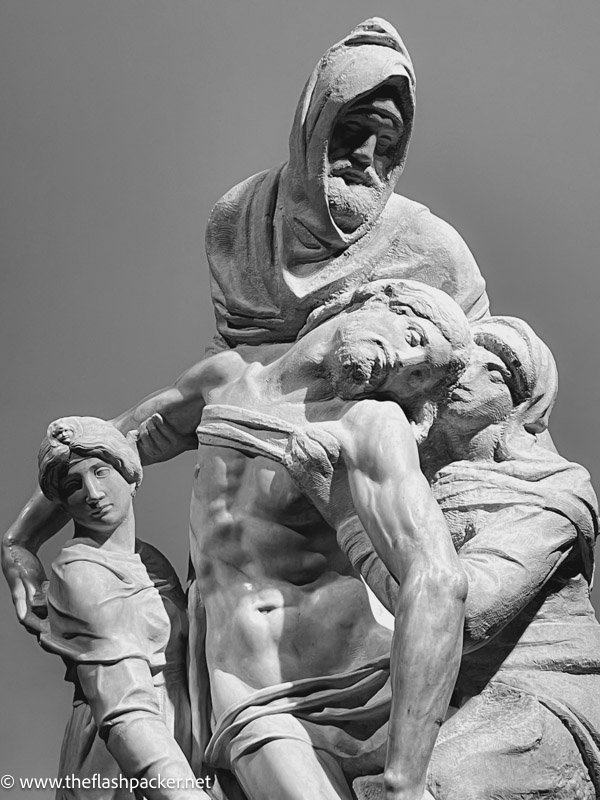
Duomo (Cathedral of Santa Maria del Fiore)
The Cathedral of Santa Maria del Fiore, known simply as the Duomo, is Florence’s visual and geographic centre. If you get lost, just look upwards for its iconic dome.
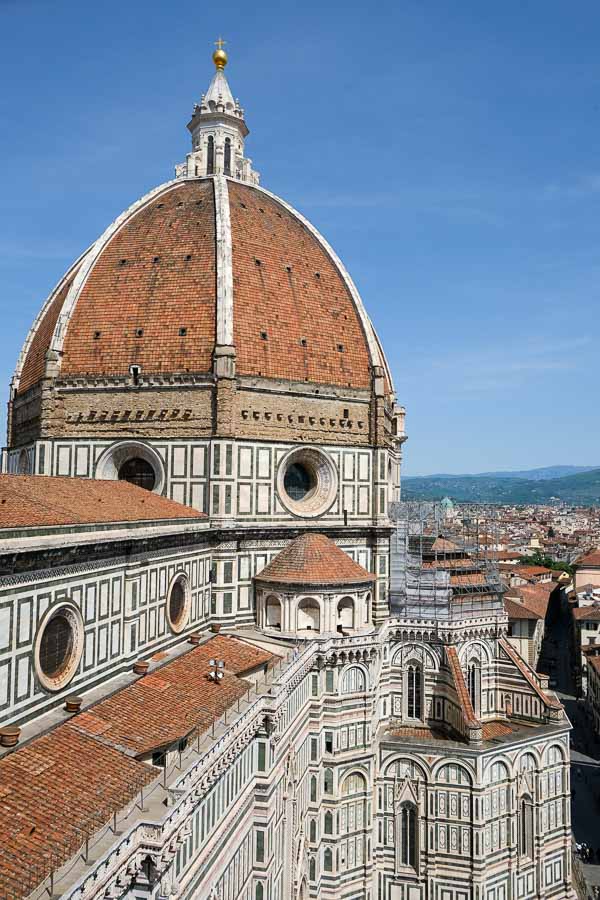
Work began on Florence’s new cathedral in 1296. The man for the job was Arnolfo di Cambio, the architect responsible for many of the city’s buildings at this time, as well as the Duomo of Orvieto.
It is not a typical 14th-century Gothic cathedral. The façade of Florence Cathedral is an explosion of pink, green and white Tuscan marble.
But Brunelleschi’s magnificent dome is the building’s architectural claim to fame. Constructed between 1420 and 1436, this terracotta dome appears to defy gravity.
Inside, the dome is decorated by Giorgio Vasari, artist, architect and the most important art historian of the time. Vasari’s frescoed dome notwithstanding, it’s safe to say that Florence Cathedral is far more impressive on the outside than inside.
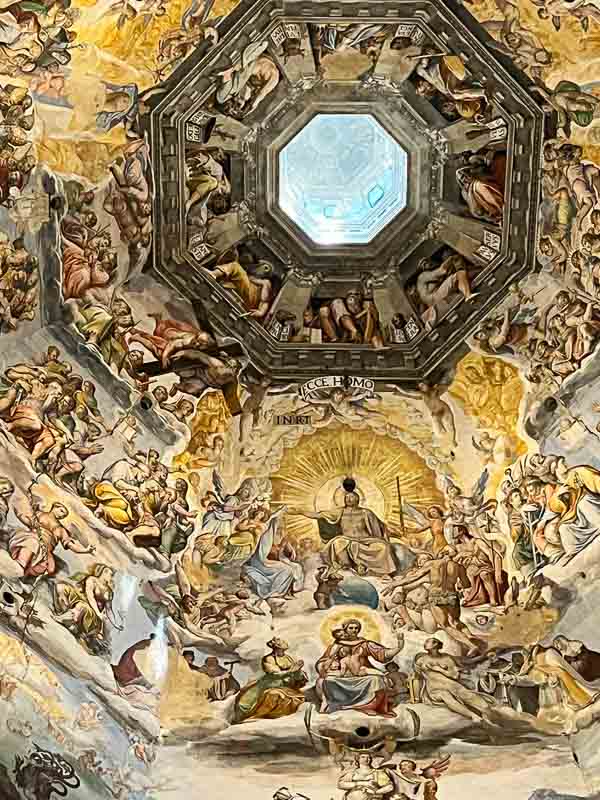
BONUS TIP: Queues to enter the Duomo can be epic, but you can skip the line if you have any of the Duomo complex tickets. Enter through the doorway marked Santa Reparta.
Basilica of Santa Reparta
After you have looked at Vasari’s Last Judgement, it’s worth paying a quick visit to Santa Reparta in the bowels of the cathedral.
Dating from 405 AD, this ancient basilica provides the most tangible evidence of early Christianity in Florence. Santa Reparta’s highlight is a fine polychrome mosaic with geometrical decorations, including the cross motif.
Giotto’s Bell Tower (Campanile)
Piercing the sky above Florence’s historic centre, this 270-foot bell tower was designed by Giotto and built between 1334 and 1359.
In my view, Giotto’s Bell Tower offers a viewpoint of Florence at least equal to that from Brunelleschi’s dome. There are sensational views in all directions, including those of the red-brick dome itself.
It also has marginally fewer steps than the dome, 414 to the dome’s 436. That said, it’s still a strenuous climb in places.
But those views make it so worthwhile.
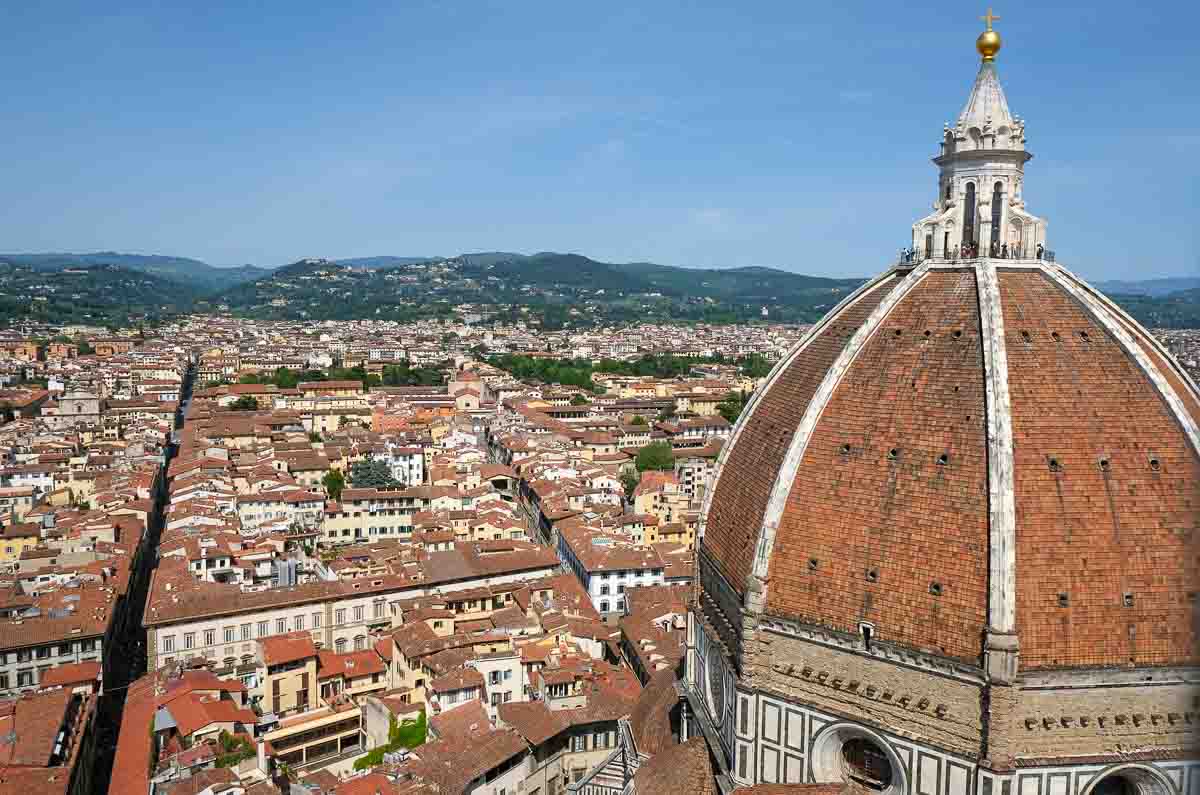
St. John’s Baptistery
Completed in 1128, the Baptistery of St. John is beautiful inside and out.
It was the competition to design its bronze doors that kick-started the Renaissance. A copy of Ghiberti’s famous bronze “Gates of Paradise” graces the eastern side of this octagonal building.
Step inside the Baptistery to admire its golden medieval mosaic ceiling, covered with scenes from Genesis, the lives of Christ, St. John the Baptist and Joseph the Patriarch, and the Last Judgement.
![A 3-Day Florence Itinerary You'll Want to Steal 10 gold mosaic of jesus on judgement day ]](jpg/a-florence-baptistry-11.jpg)
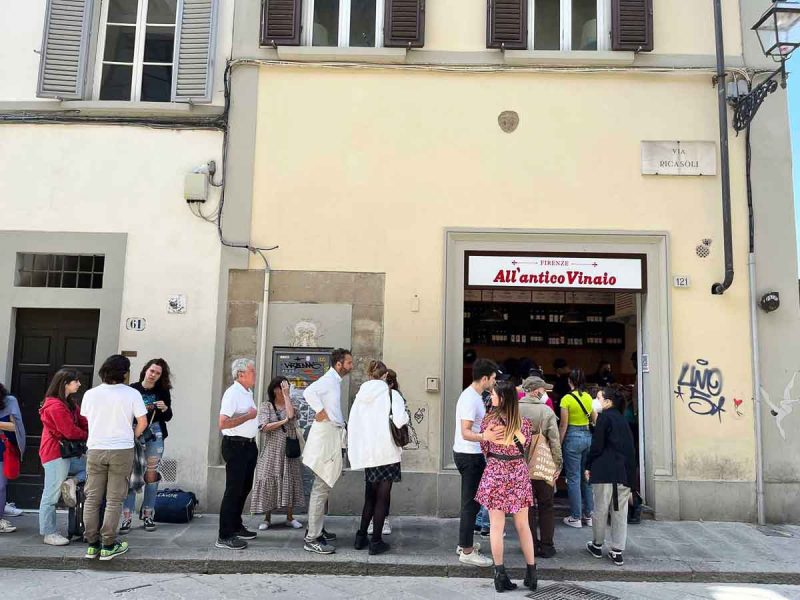
TIME FOR LUNCH?
After a busy start to your first day in Florence, it’s time to break for lunch. If there’s one thing that the city is not short of it is places to eat.
I recommend the legendary All’Antico Vinaio, whose sandwiches are made with schiacciata, a local bread. Cheap and delicious wine is also on offer.
It is on Via dei Neri a two-minute walk from Piazza dell Signoria. There is another shop on Via Ricasoli, near the Accademia.
PIAZZA SIGNORIA
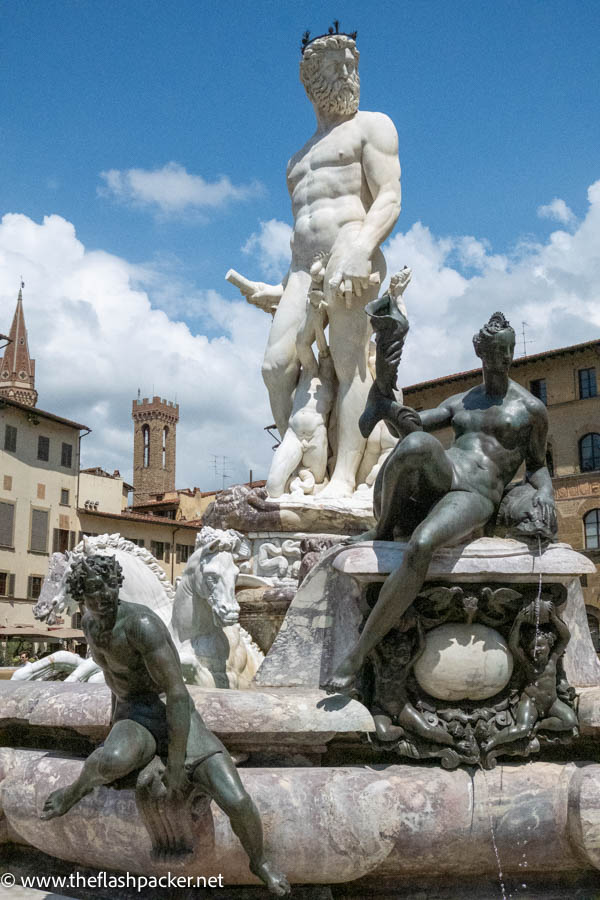
This staggeringly beautiful square has been the heart of Florence’s political and social life since the days of the Medici. Here you’ll find Palazzo Vecchio, the monumental Fountain of Neptune and Loggia dei Lanzi, home to some of Florence’s finest free sculptures.
UFFIZI GALLERIES (LE GALLERIE DEGLI UFFIZI)
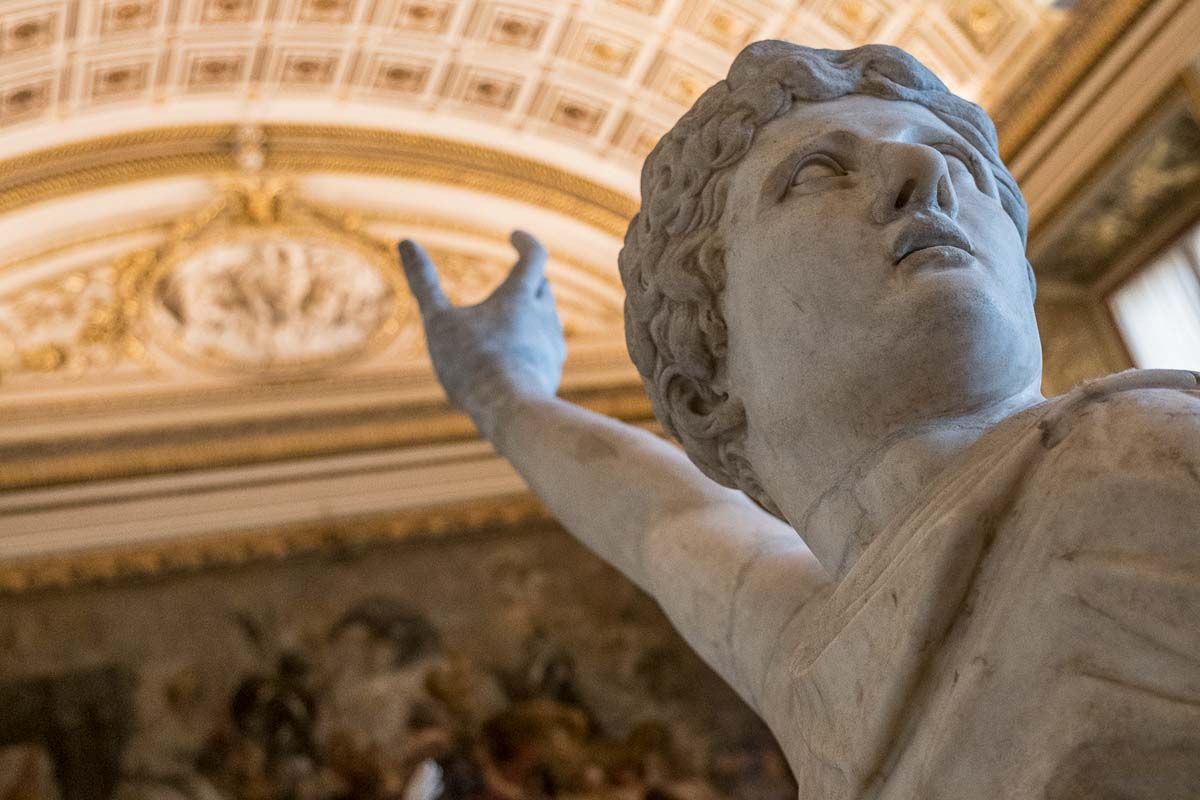
The Uffizi Galleries is an essential item on any Florence bucket list, whether you are spending one, two or three days in Florence.
Housed in a 16th-century building designed by Vasari, it is home to the greatest collection of Italian art in the world. Many of the best paintings in Florence are here, from Giotto’s early stabs at realism and perspective to Caravaggio’s magnificent Medusa.
There are works by the top trio of the High Renaissance – Botticelli, Michelangelo and Leonardo da Vinci – as well as those by Raphael, Titian and many others.
I recommend spending at least a few hours at the Uffizi Galleries. However, if your time is limited, concentrate on the big hitters of the Renaissance.
These are the must-see halls of the Uffizi Galleries:
- Hall 2 (Giotto & the 13th Century)
- Hall 7 (Masaccio, Veneziano and Paolo Uccello)
- Hall 8 (Filippo Lippi)
- Halls 10-14 (Botticelli),
- Hall 15 (Leonardo)
- Hall 41 Michelangelo)
- Hall 66 (Raphael)
- Hall 83 (Titian)
- Hall 90 (Caravaggio)
As a bonus, a window at the end of the gallery’s great hallway opens out onto one of the best views of Florence. You can also eyeball some of Florence’s most iconic landmarks from the Uffizi’s terrace café (but lunch here will blow a hole in your holiday budget).
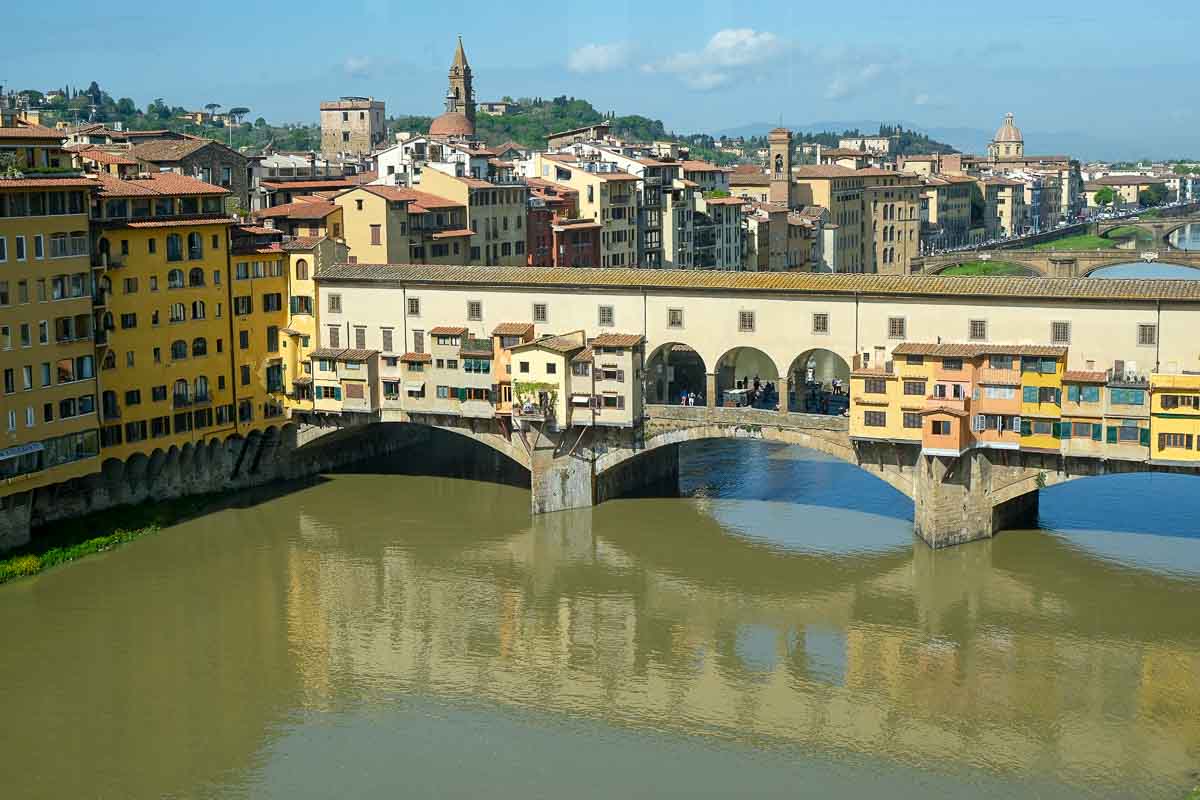
Buying tickets for the Uffizi Galleries
My advice is to book your ticket for the Uffizi as soon as you know your dates in Florence. The cheapest way of doing this is through the Uffizi’s official website here.
You have two choices: a single ticket or a combination PassePartout ticket. I bought the PassePartout ticket, which is valid for five consecutive days and covers admission to the Uffizi, Pitti Palace and Boboli Gardens. It’s your best bet if you plan to visit all three of these places (they are all in this itinerary).
If the official website shows no availability, you might have better luck buying your ticket here. This is likely to be a more expensive option but it comes with free cancellation within 24 hours of your visit.
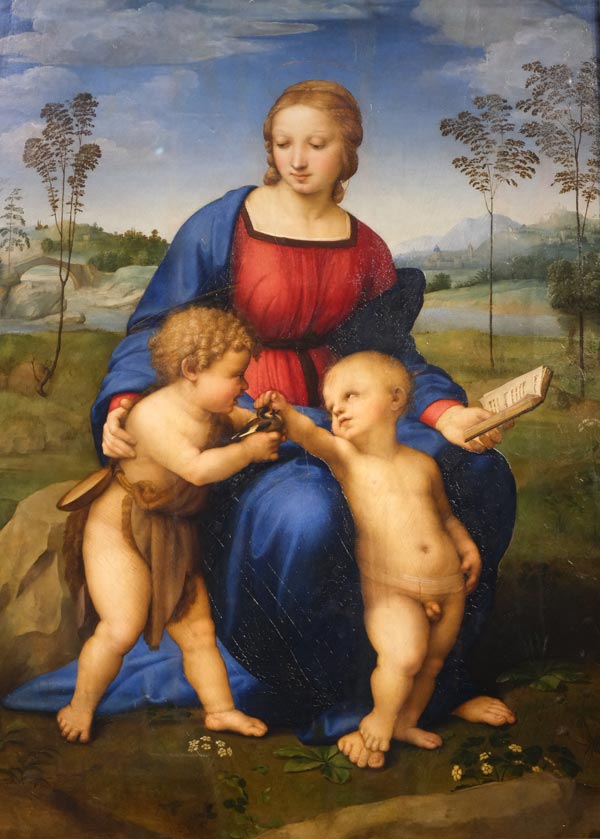
If you are not familiar with art history and don’t have a decent guidebook, I recommend taking a guided tour of the Uffizi Galleries. It’s an excellent way to learn more about Renaissance art and the city of Florence.
Here are a few options that are worth considering
Uffizi Galleries Guided Tour
Benefit from a priority entrance ticket and discover the masterpieces of Italian art in the company of a licensed guide in this 2-hour tour.
>>> CLICK HERE TO BOOK YOUR TOUR
Uffizi Galleries Skip-the-Line Audio Guided Tour with Host
If you want the best of both worlds, this affordable tour combines a pre-recorded commentary with a live guide and a skip-the-line ticket.
>>> CLICK HERE TO BOOK YOUR TOUR
Walking tour of Florence with guided visits to the Uffizi and Accademia Gallery
You get a lot of bang for your buck in this four-hour walking tour that includes entry and a guided visit to the Uffizi and the Accademia Gallery.
>>> CLICK HERE TO BOOK YOUR TOUR
PONTE VECCHIO
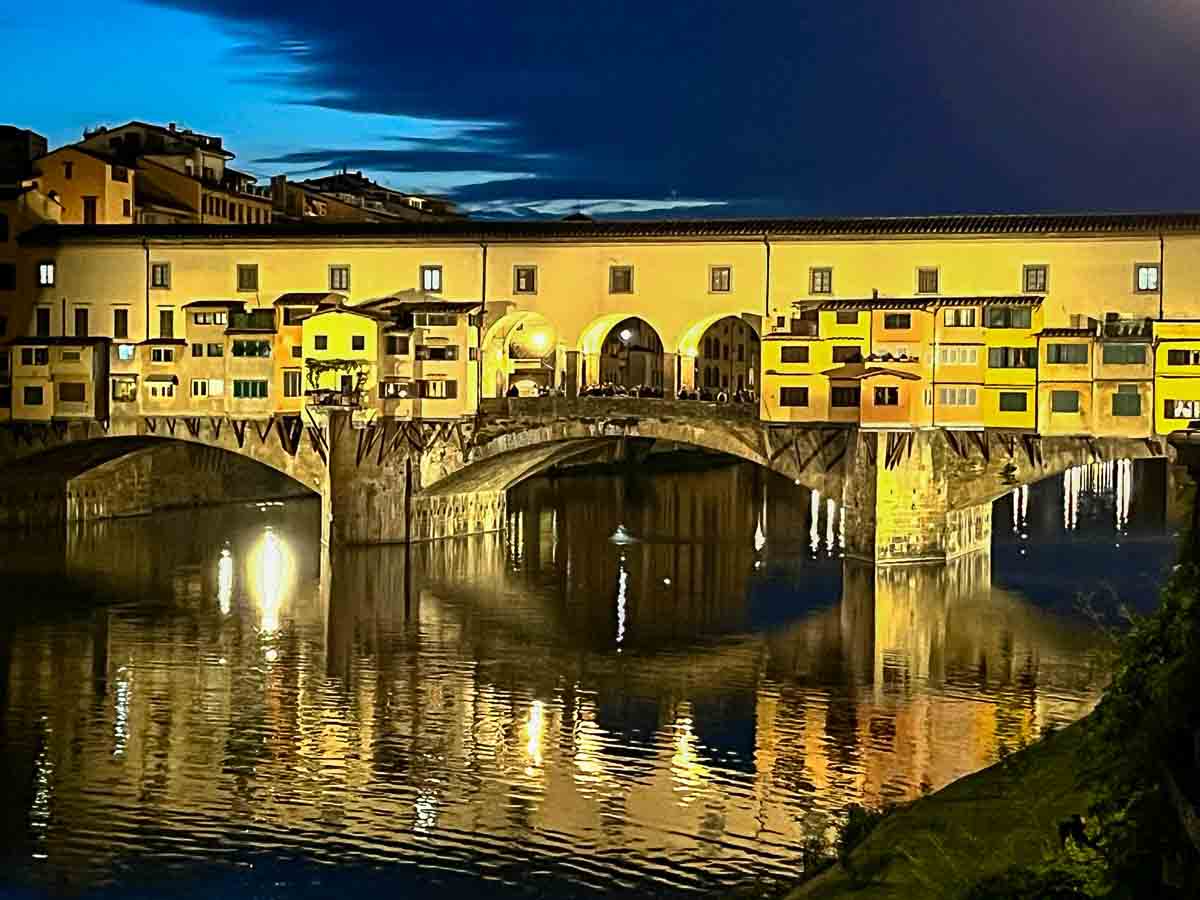
Adjacent to the Uffizi Galleries is the beautiful Ponte Vecchio, the best-known of Florence’s bridges. Its image has been used as a backdrop to many of the finest films set in Italy.
Butchers’ shops once lined Ponte Vecchio, using the Arno River as a convenient waste disposal system. When the Medici family built the Vasari Corridor over the Ponte Vecchio, connecting the Pitti Palace with the Palazzo Vecchio, they objected to the stench. From that day until now, gold and silver shops replaced the meat market.
DAY 2: Michelangelo and the Medici (San Marco, Galleria Accademia, Bargello Museum and Santa Croce)
The stories of the Medici and Michelangelo are woven into that of the city of Florence itself.
Painter, sculptor, architect and poet: Michelangelo was a true Renaissance man. Despite spending much of his life in Rome, he was Florentine through and through, and the city is liberally sprinkled with the “Divine Master’s” artistic achievements.
He learnt his craft with the powerful Medici family, under whose rule Florence prospered and the Renaissance flourished.
On the second of your 3 days in Florence, you will visit places associated with Michelangelo and the Medici.
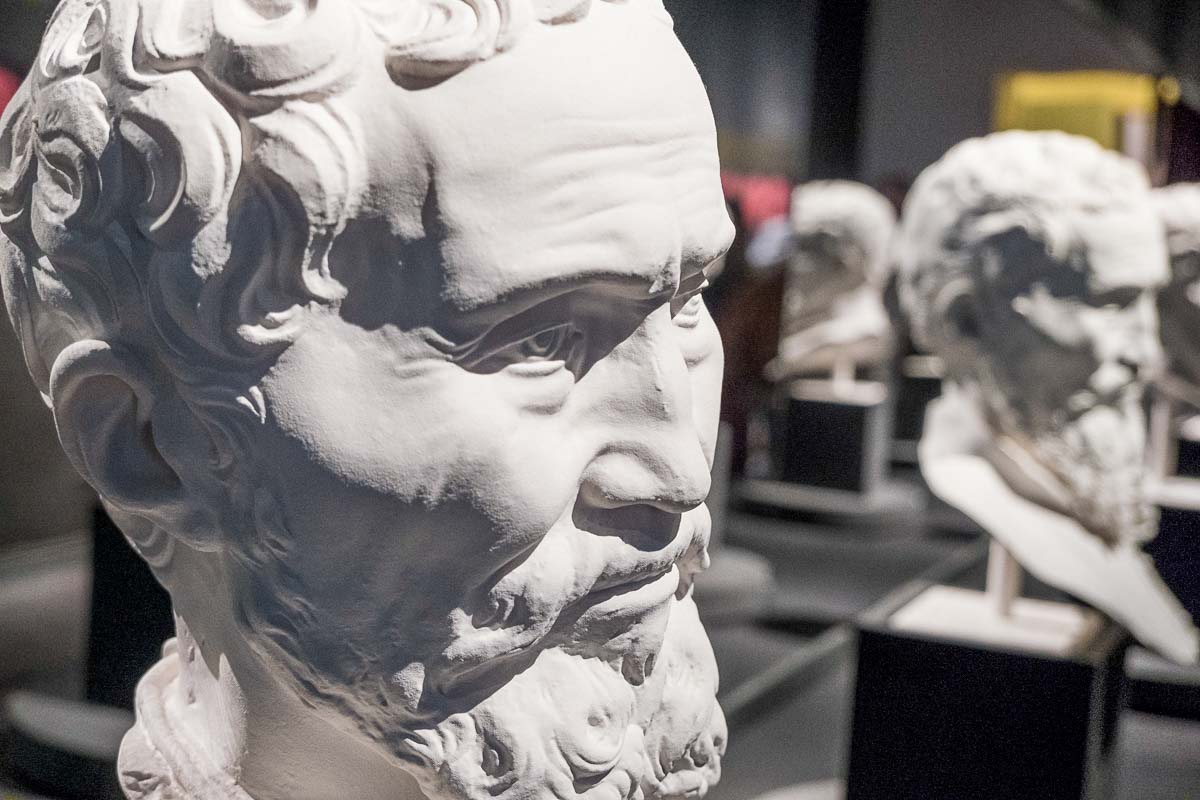
SAN MARCO
One of Florence’s most underappreciated places to visit is the former monastery of San Marco.
Now a museum, this is home to the finest collection of frescoes by Fra Angelico (1395 – 1455). He was one of the most important painters of the Early Renaissance, whom Vasari described as possessing “a rare and perfect talent.”
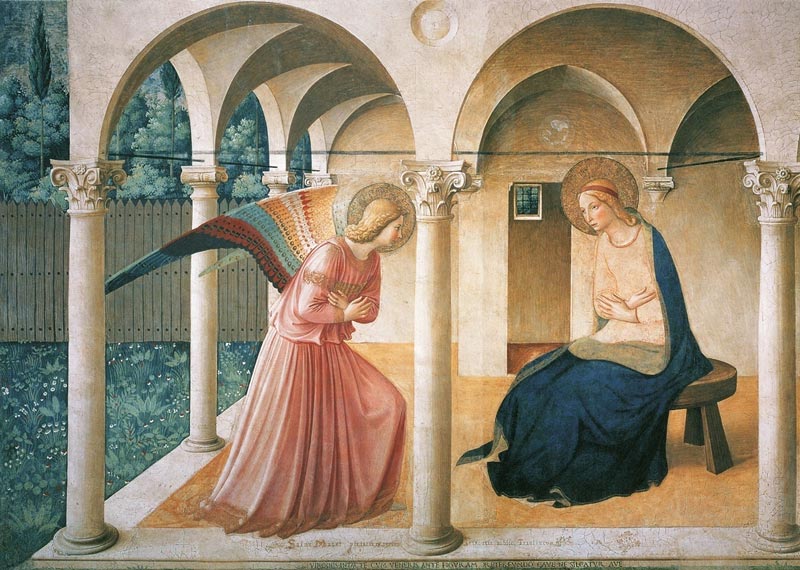
San Marco was restored and enlarged for Cosimo the Elder de’ Medici and was once home to Girolamo Savonarola. This fire-and-brimstone preacher almost succeeded in bringing down the Renaissance.
The opening hours for San Marco are almost Byzantine and prone to sudden change. Although you can check these here, experience has shown me they may not reflect the actual hours.
ACCADEMIA GALLERY (GALLERIA DELL’ACCADEMIA)
A few blocks south of San Marco is the Galleria dell’Accademia di Firenze, known simply as the Accademia. This is famously the home of Michelangelo’s sculpture of David.
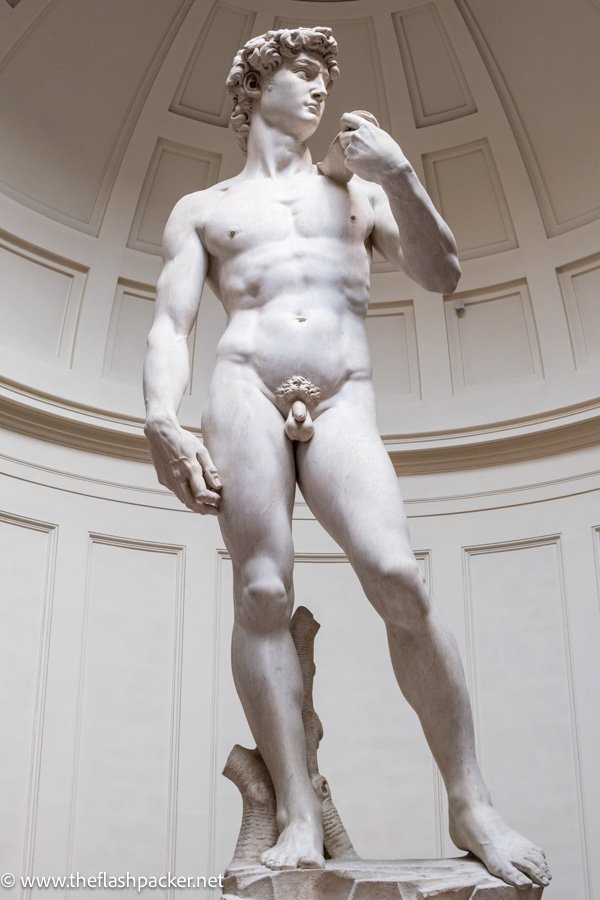
Standing 17 feet high, this buff biblical shepherd is a symbol of both the Renaissance and the city of Florence. Crafted from gleaming white marble from the quarries in Carrara in Tuscany, David is the embodiment of the perfect male.
However, the giant-slayer isn’t the only reason for visiting the Accademia.
Michelangelo’s unfinished works, known collectively as The Prisoners or Slaves, provide an extraordinary insight into his creative process and understanding of the human body.
The Prisoners were created between 1516 and 1534 and were intended for the ill-fated tomb of Julius II, Michelangelo’s papal boss.
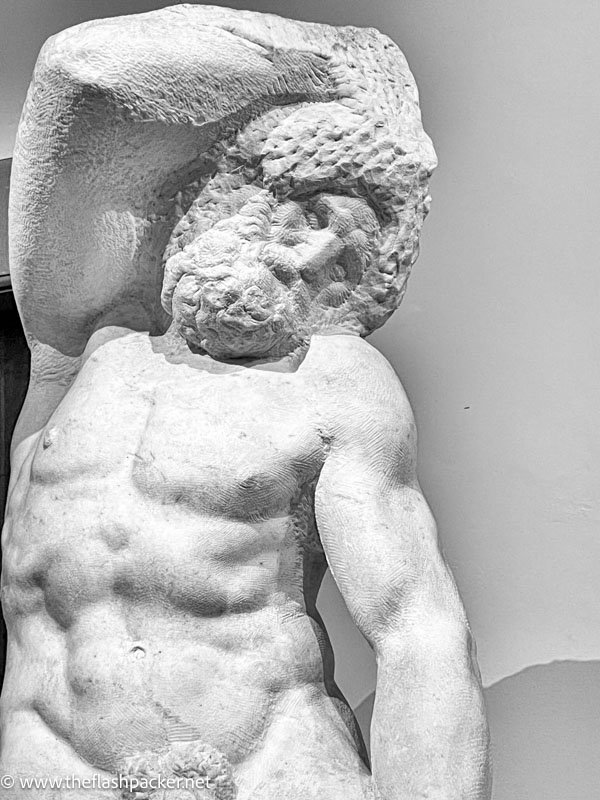
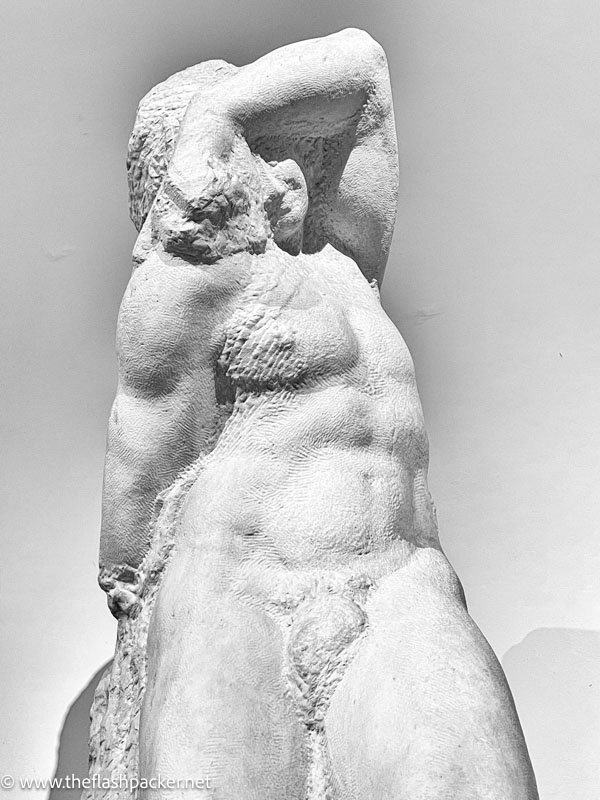
Buying tickets for the Accademia
Advance purchase of tickets for the Accademia is essential. Buy them from the gallery’s official website here. Failing that, try buying your ticket via a 3rd party here.
If you want to learn more about Michelangelo and David, click here to join an affordable group tour with an art historian.
BARGELLO MUSEUM (MUSEI DEL BARGELLO)
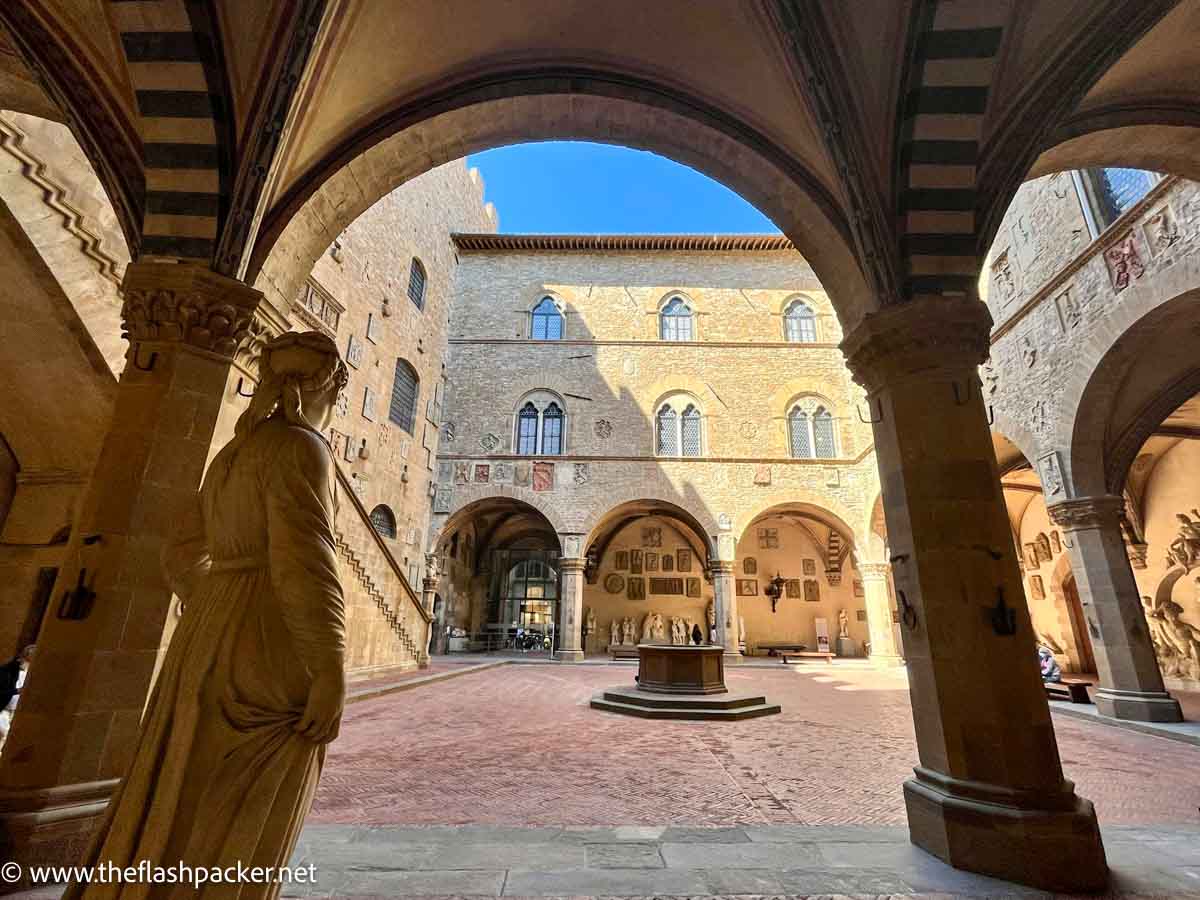
The Bargello Museum is home to many of the greatest sculptures in Florence. Housed in a rustic former palazzo that resembles a mini Palazzo Vecchio, its collection of statues spans 150+ years of Florence’s artistic heyday.
This is where you can see the winning entry (Lorenzo Ghiberti) and the runner-up (Brunelleschi) in the contest to design the doors of the Baptistery. Their brief was to depict the sacrifice of Isaac (Genesis 22).
There’s a handful of Michelangelo sculptures, including his debauched Bacchus (1496) and noble Brutus (1540), as well as works by Donatello and Giambologna.
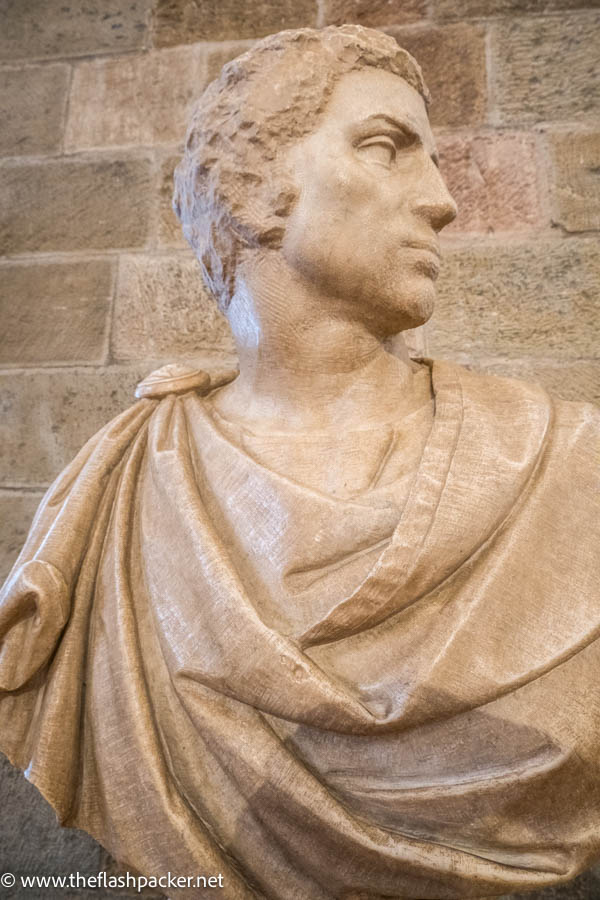
Buying tickets for the Bargello Museum
As the Bargello is criminally under-visited, you should be able to buy a ticket on the day. But if you want to buy a ticket in advance, here’s the official website.
If you want to learn more about Michelangelo and Donatello, join this guided tour of Bargello which includes your admission ticket, or book a private tour here.
SANTA CROCE
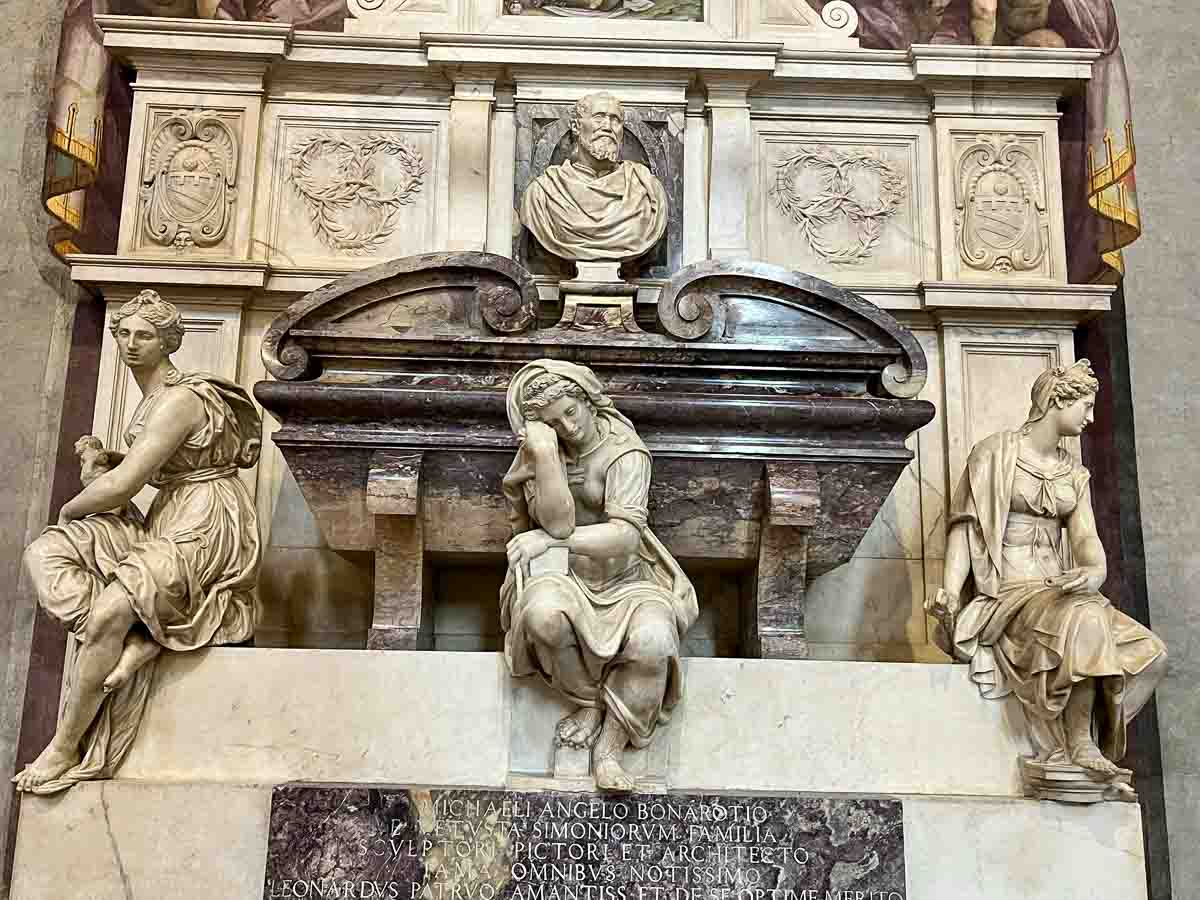
The Franciscan Santa Croce Church is the final resting place of the great and the good of Florence, including Michelangelo, Dante, Galileo, Machiavelli and Rossini.
This 14th-century church is also famous for its fresco cycle by Giotto, one of the first Renaissance painters. Giotto condensed the stories from the Life of St. Francis into seven episodes, covering the walls of the church’s Bardi Chapel.
There is a famous leather school to the rear of the church and Piazza Santa Croce is lined with shops, bars and restaurants.
You should be able to buy a ticket to visit Santa Croce on the day. Click here for opening hours and ticket prices.
DAY 3: Timeless views in the Oltrarno (Brancacci Chapel, Pitti Place, Boboli Gardens, Piazzale Michelangelo, Rose Garden and San Miniato )
It’s your last day in Florence and time to cross the river to the Oltrarno, literally “on the other side of the Arno.” This is the Florence that tourism left behind and is home to palaces, churches, gardens and some of the best views in town.
BRANCACCI CHAPEL IN SANTA MARIA DEL CARMINE
Welcome to my favourite church in Florence and one of the most important in terms of art history.
The Brancacci family were patrons of this chapel in the Church of Santa Maria del Carmine from the mid-1300s until 1780. They commissioned the decoration of the chapel in 1424.
Designed by Masolino da Panicale, work on the fresco cycle was taken over by his pupil Masaccio until his untimely death in 1428.
Masaccio was the first great painter of the Italian Renaissance, mastering linear perspective like never before. He wallpapered the walls of the Brancacci Chapel with vivid and expressive frescoes centred around the life of St. Peter.
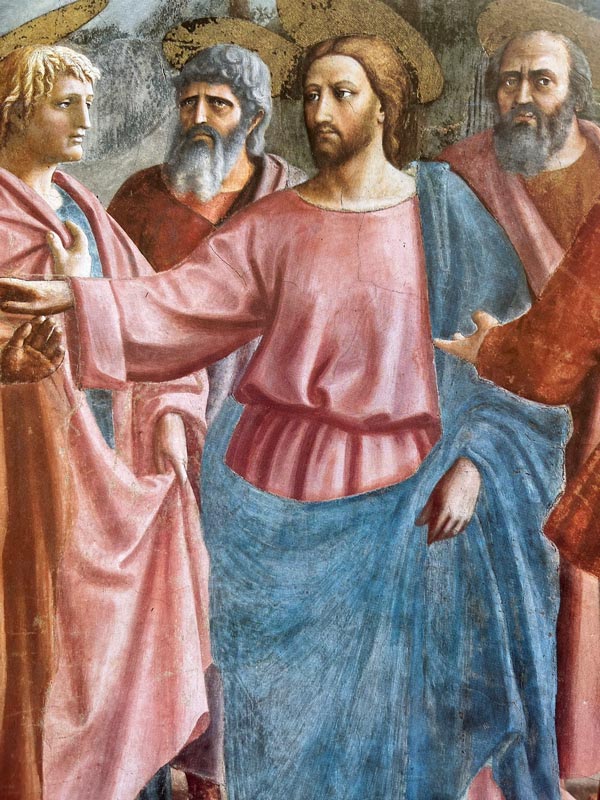
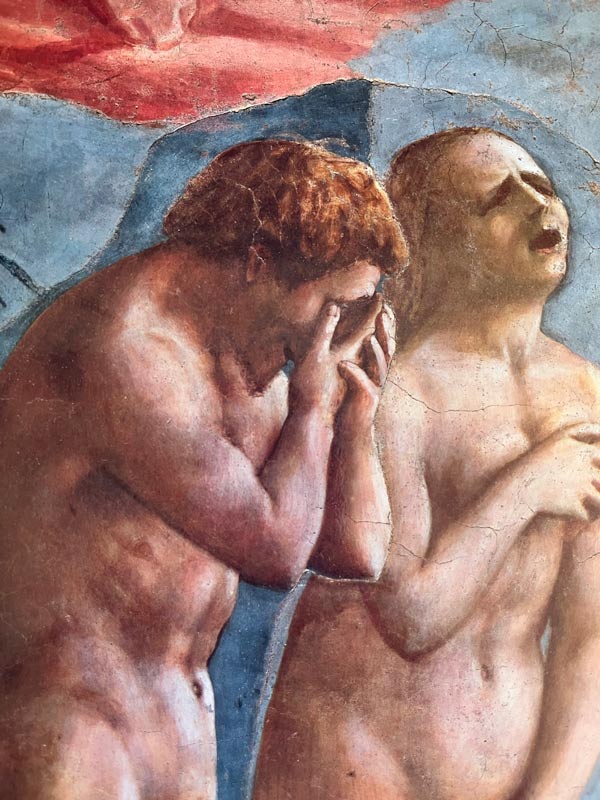
For information on ticket prices and opening hours, click here.
PITTI PALACE & BOBOLI GARDENS
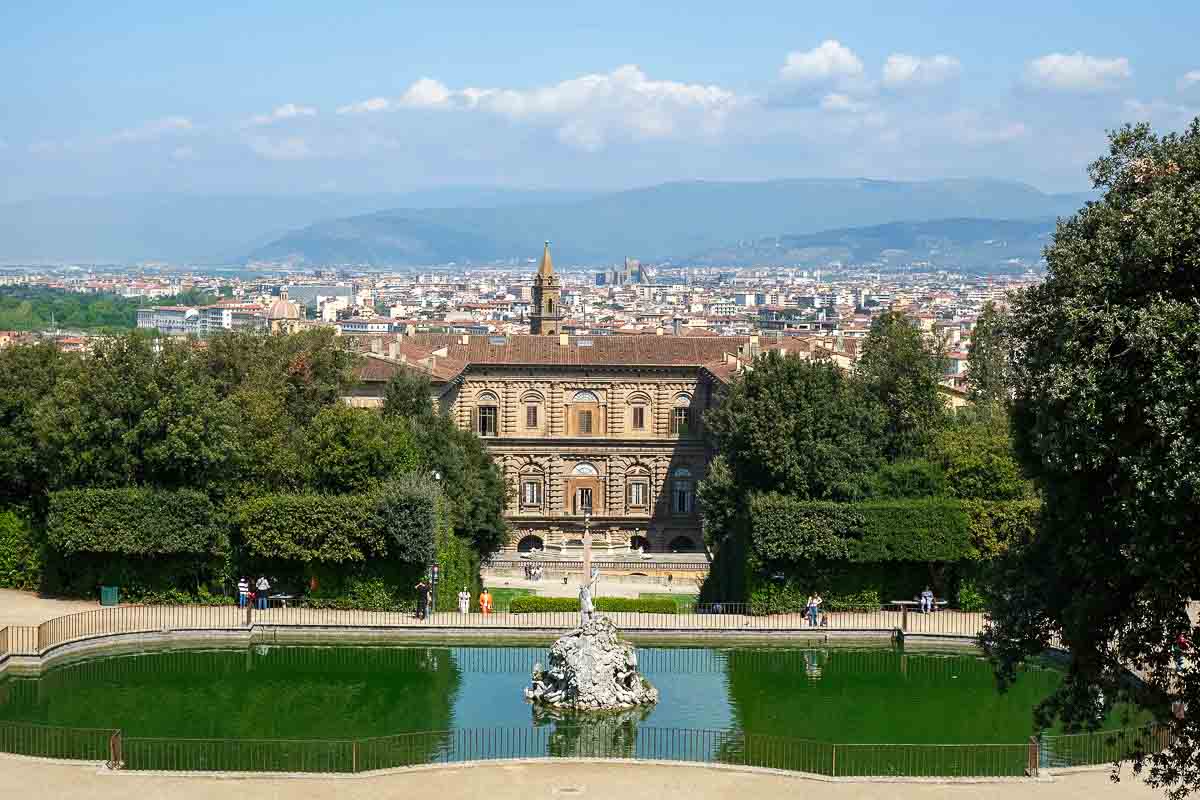
The Pitti Palace was purchased in 1550 by Cosimo I de’ Medici.
Today, the Palace is divided into four museums: the Treasury of the Grand Dukes, the Palatine Gallery and the Imperial and Royal Apartments, the Gallery of Modern Art and the Museum of Costume and Fashion.
The Palatine Gallery is far and away the most important of the museums of the Pitti Palace. It houses the world’s finest collection of Raphael Madonnas, Titian portraits and other outstanding artworks.
The beautiful Boboli Gardens form the backyard of the Palazzo Pitti. Stretching over 11 tranquil acres, there are elegantly landscaped gardens, Renaissance sculptures and gushing fountains.
Visiting Pitti Palace & Boboli Gardens
You can buy your ticket through the official website here. Choose between a single ticket for each attraction, a ticket for both the palace and the gardens, or a combination PassePartout ticket.
There is very little information in the Pitti Palace and the signage is confusing. This is one place in Florence where it pays to carry a decent guidebook.
Better still, book a guided tour of the Pitti Palace or one that also covers the Boboli Gardens here.
PIAZZALE MICHELANGELO
Are you ready for that classic postcard view of Florence?
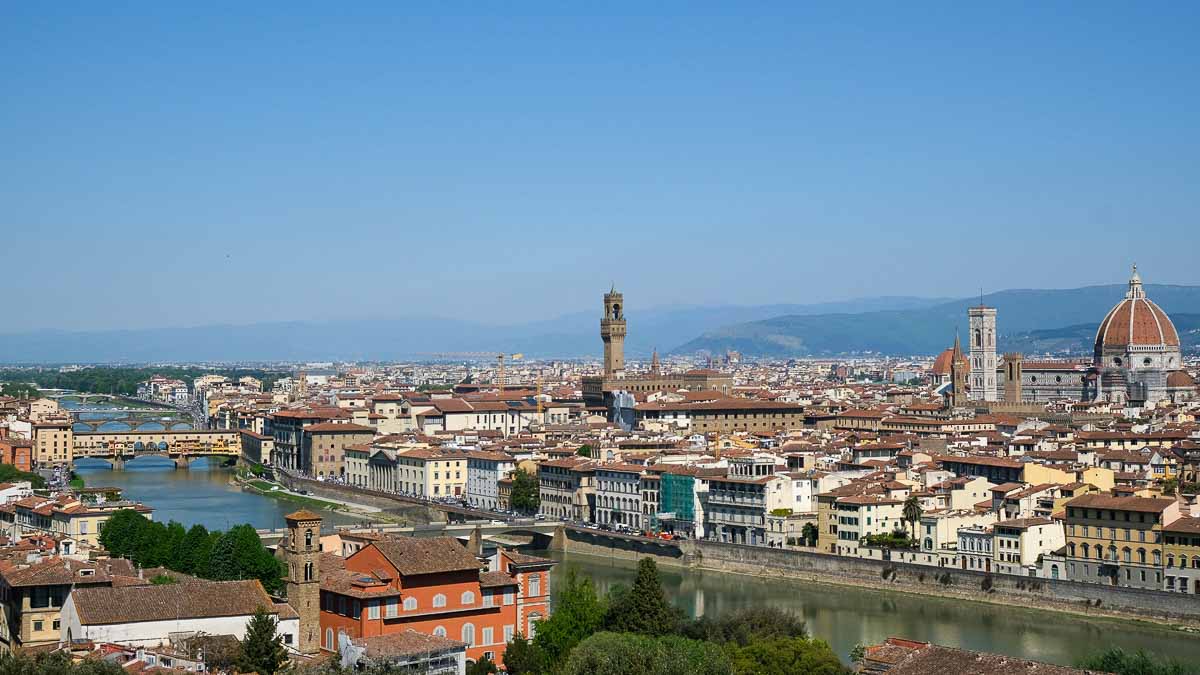
At Piazzale Michelangelo, Florence’s major landmarks are laid out before you in all their splendour, from Brunelleschi’s terracotta dome to the series of graceful bridges spanning the Arno River. There’s also a good café with a spacious outside terrace and a knock-off David in the centre of the square.
Thanks to those views, this is a super-touristy spot littered with stands selling “Made in China” tatt. But as it’s a vast space, it’s fairly easy to escape the coach parties.
Getting to Piazzale Michelangelo
From the Ponte Vecchio, it’s a 15-minute uphill schlep to Piazzale Michelangelo. This is steep in places.
If you don’t fancy the walk –and who would blame you – catch a bus. Choose between bus #12 (from Boboli Gardens), bus #13 (from Ponte San Nicolò) or the hop-on-hop-off bus.
ROSE GARDEN
For all of its popularity, there are viewpoints that are at least equal to Piazzale Michelangelo.
The first of these is my favourite Florence photo spot, the Rose Garden, which you will find just below Piazzale Michelangelo. It’s a peaceful refuge, filled with fragrant rose bushes and home to a Japanese garden donated by Kyoto, Florence’s twin city.
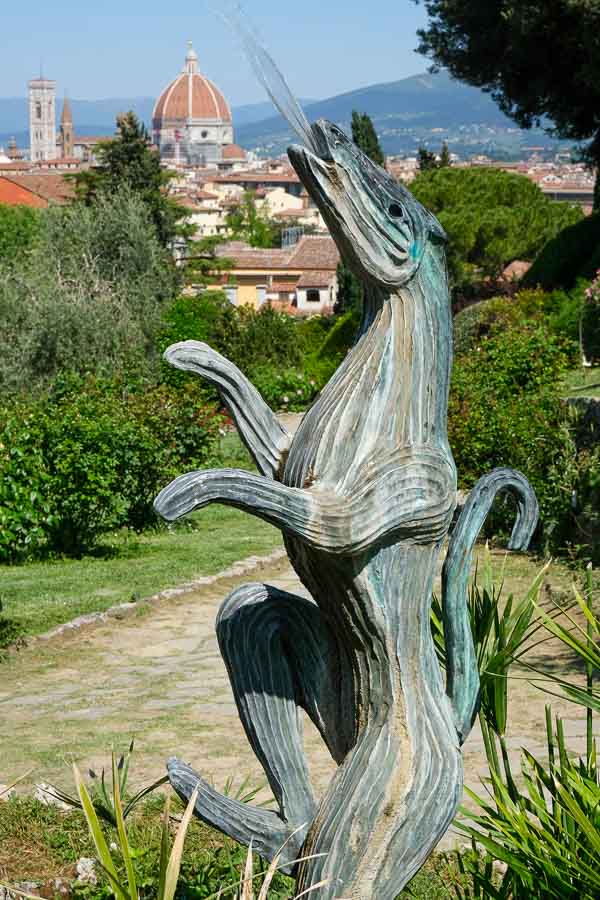
It also has a cheap and friendly coffee bar with outside tables. Best of all, like Piazzale Michelangelo, entry to the Rose Garden is free.
SAN MINIATO
Five minutes uphill from Piazzale Michelangelo, San Miniato al Monte is the oldest church in Florence. It is dedicated to St. Minias who was beheaded on the banks of the Arno in 250 AD and has an art-filled sacristy and a ceiling of glazed terracotta panels.
However, most people stop here for panoramic views of Florence.
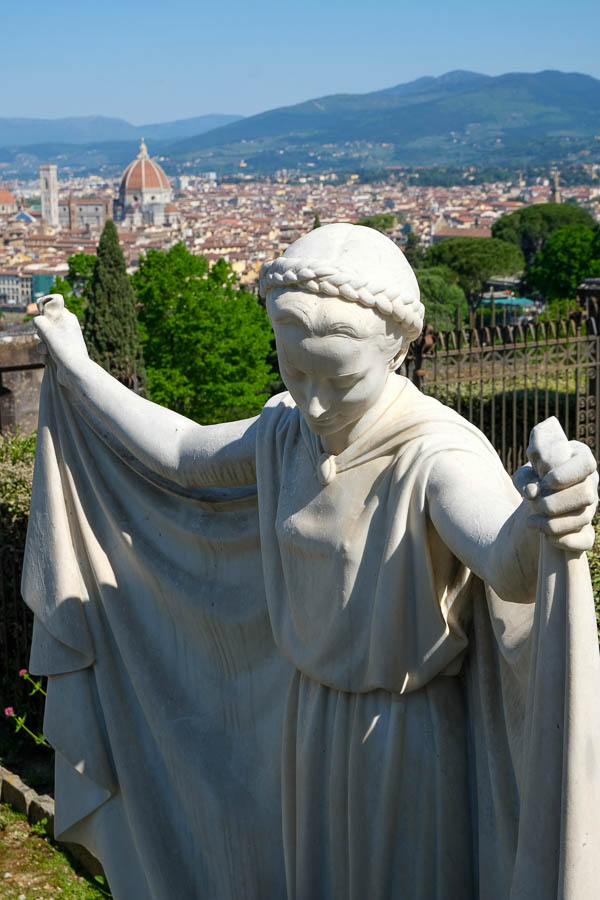
BONUS TIP: Visit in the late afternoon on weekdays to hear the monks singing Gregorian chants. More information here.
Other Places to Visit in Florence
Let’s face it. We are all different, and you might be looking for other things to do during your 3 days in Florence that better reflect your interests. Here are a few places I love.
Orsanmichele
A former grain market-turned-church for Florence’s guilds and merchants. It is widely thought to be where the Renaissance began and is famous for its statues.
Palazzo Vecchio
The Town Hall of Renaissance Florence was appropriated by Cosimo I de’ Medici (1519 – 1574) as his lavish palace. Visit Cosimo’s apartments for their artwork and climb Arnolfo’s Tower for some of the best views of Florence.
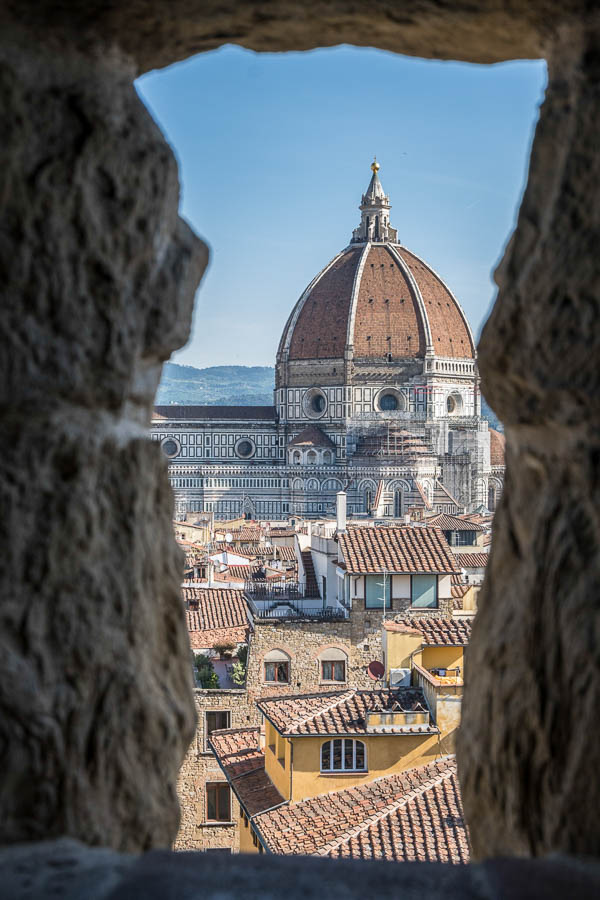
Ricardi Medici Palace
The former home of Lorenzo the Magnificent (1449 – 1492), the Ricardi Medici Palace is famous for the Benozzo Gozzoli frescoes decorating its diminutive Chapel of the Magi.
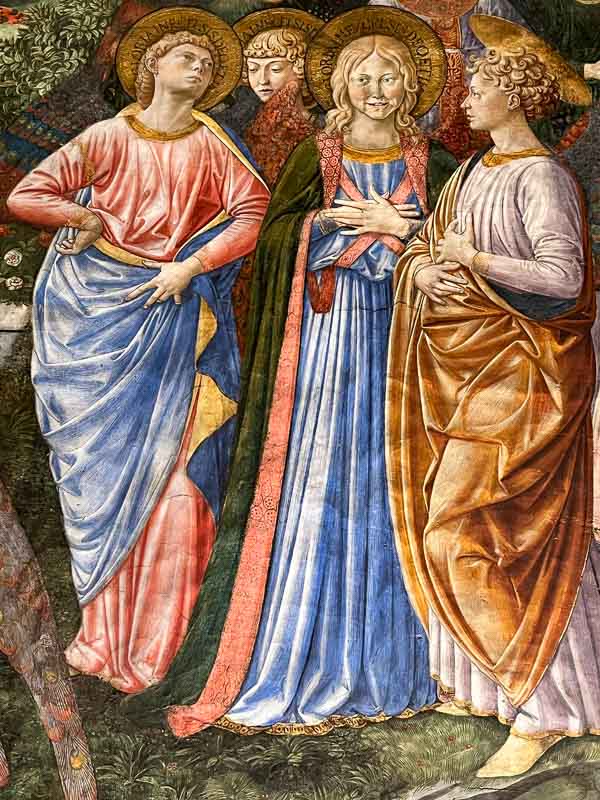
Basilica of Santa Maria Novella
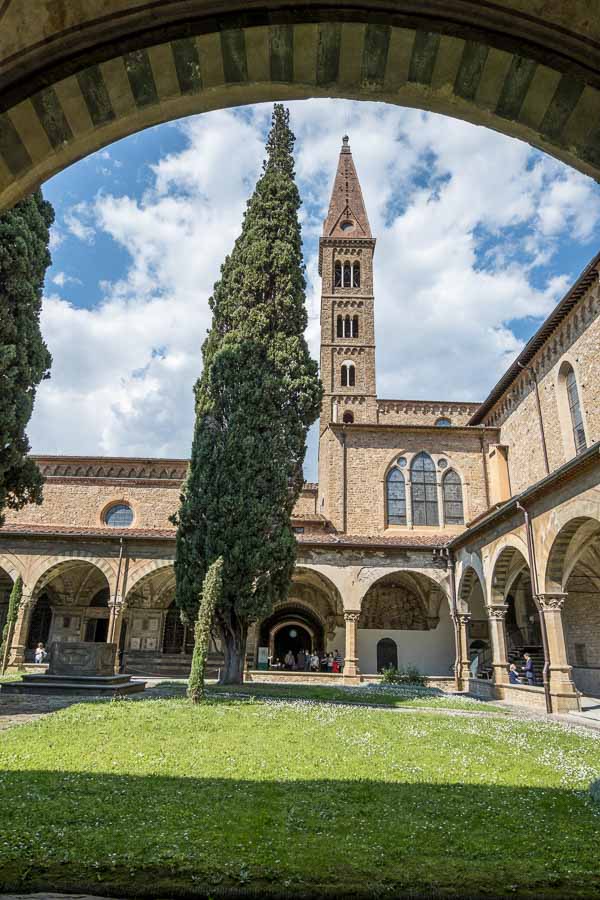
This 13th-century Dominican church is home to some artistic masterpieces, including The Trinity by Masaccio and crucifixes by Giotto and Brunelleschi. Santa Maria Novella also has a series of peaceful cloisters and a small museum.
San Lorenzo Church
The hulking Basilica di San Lorenzo is the final resting place of the principal members of the Medici. Its Laurentian Library was designed by Michelangelo.
Mercato Centrale
Foodies should visit this cathedral of food, built around 1865.
Is the Firenze Card Worth it?
Like many cities, Florence has a tourist card, the Firenze Card. This grants free entry to 60+ museums and sites in Florence over a 72-hour period.
As with any city pass, its value will be determined by your plans and the amount of time at your disposal. In 2024, it costs €85.
Although it is valid for the Accademia and Uffizi Gallery, pre-booking is obligatory and can only be done by telephoning the Uffizi or in person once you have arrived in Florence. Online reservation with the Firenze Card was not possible.
Day Trips from Florence
If you have more than three days in Florence, take the opportunity to visit one of the other great towns and cities in Tuscany and beyond.
Day trips by train
Day trips by train from Florence’s Santa Maria Novella train station are easy. You can check the times of trains operated by Trenitalia and Italo services here.
Here are a few of my favourites:
PISA
Train journey from Florence: 1 hour
Famous for its leaning tower – has to be seen to be believed – Pisa has a clutch of other interesting sights and was the birthplace of Galileo.
SIENA
Train journey from Florence: 1 hour 30 minutes
Home to one of the most beautiful main squares in Italy and a medieval masterpiece of a cathedral. I’ve written this guide to the best things to do in Siena.
LUCCA
Train journey from Florence: 1 hour 30 minutes
Known for its soaring medieval towers and city wall promenade, lovely Lucca has a charming centro storico.
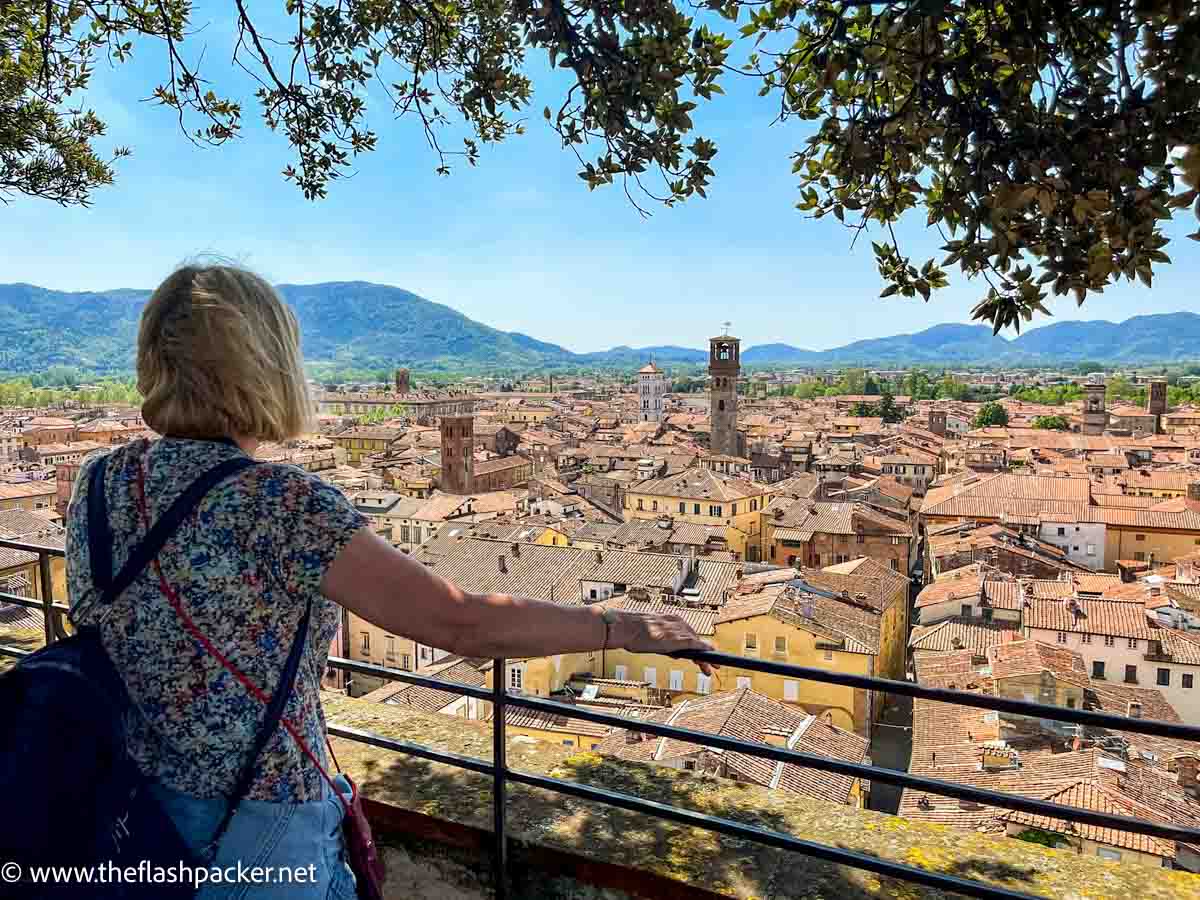
BOLOGNA
Train journey from Florence: 40 minutes
For some of the best food in Italy, visit elegant Bologna in the heart of Italy’s Emilia-Romagna region.
AREZZO
Train journey from Florence: 1 hour
An ancient Etruscan city off the main tourist trail that was once home to Giorgio Vasari.
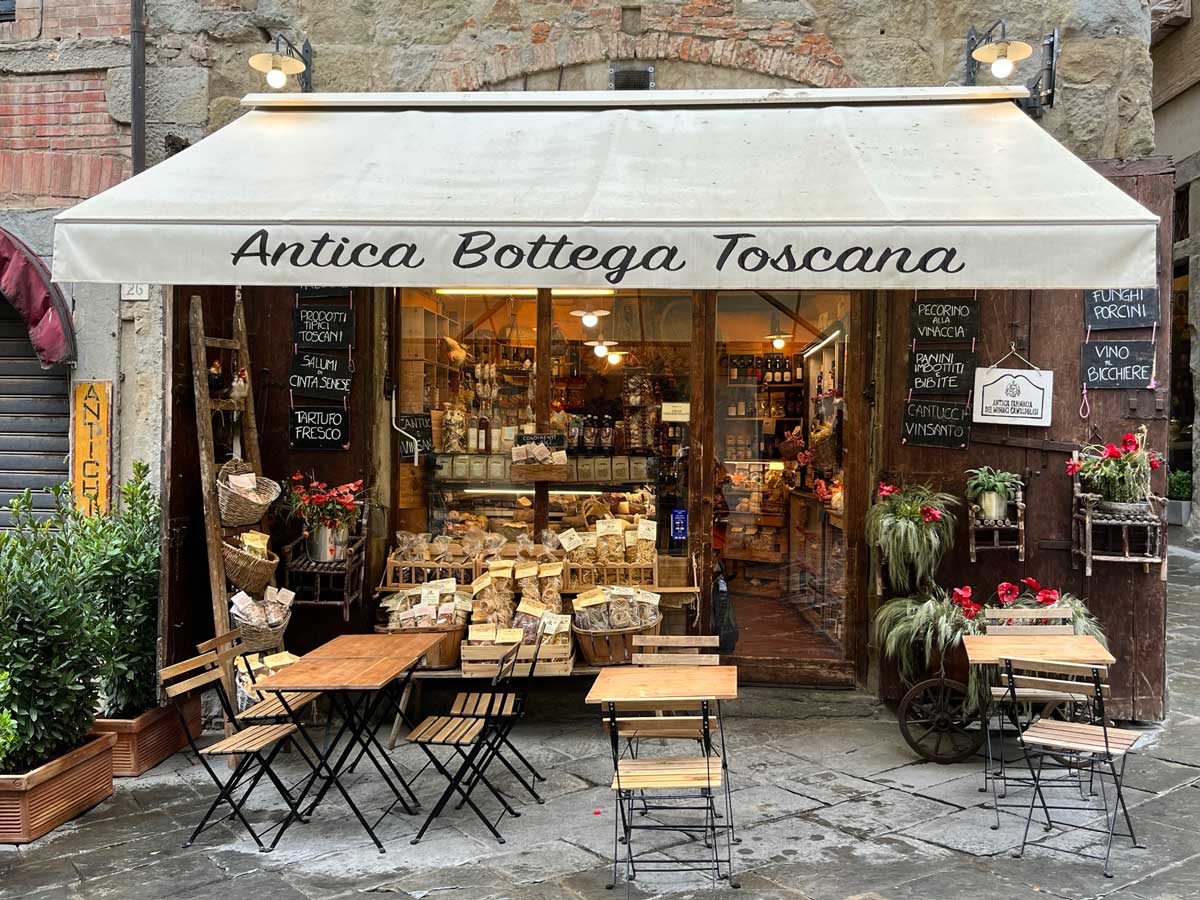
ORVIETO
Train journey from Florence: 2 hours
The Etruscan hilltop town of Orvieto is home to one of the most spectacular cathedrals in Italy and serves the best white wine on the planet.
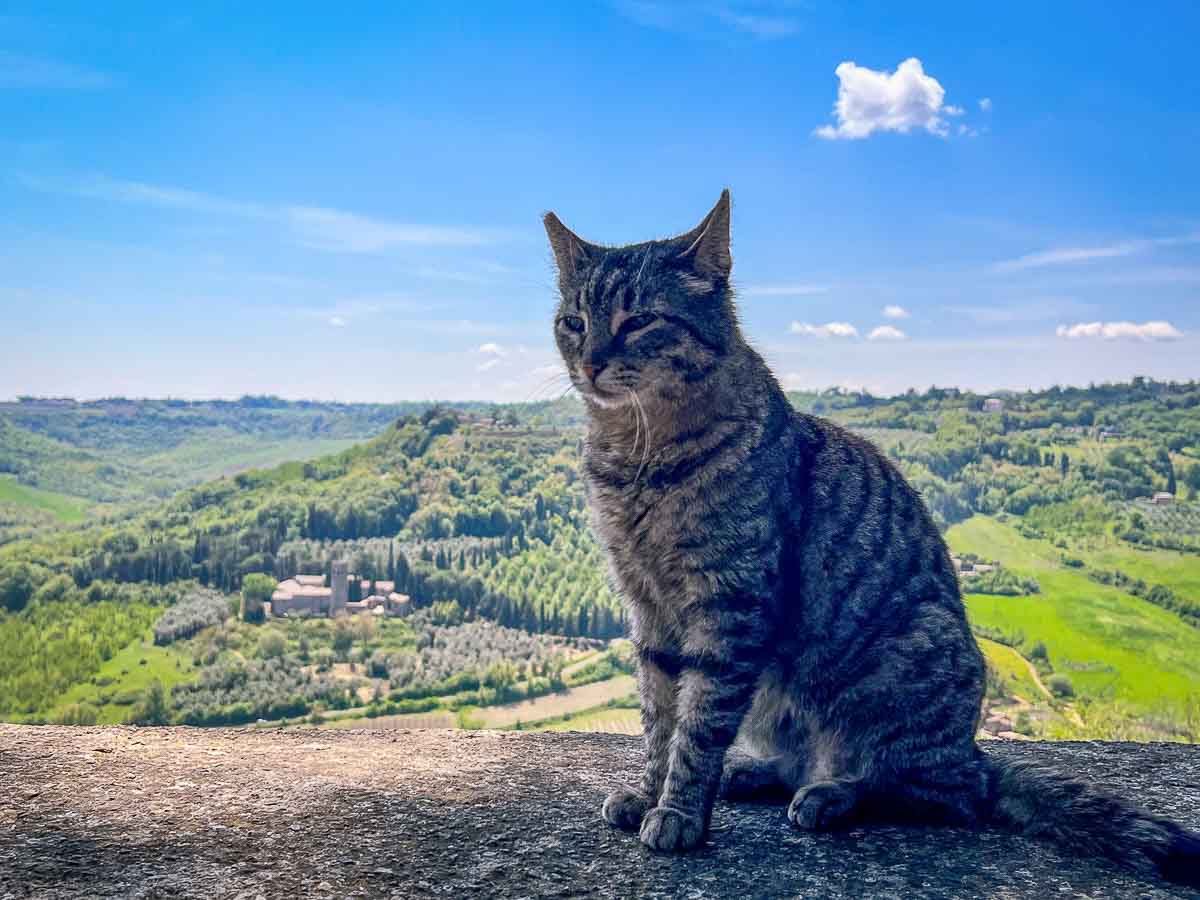
Organised day tours
For hard-to-reach places, or if you prefer someone else to make all the arrangements, join an organised tour. That way you will benefit from the knowledge of a local guide, and it is also an excellent way to meet other people as a solo traveller.
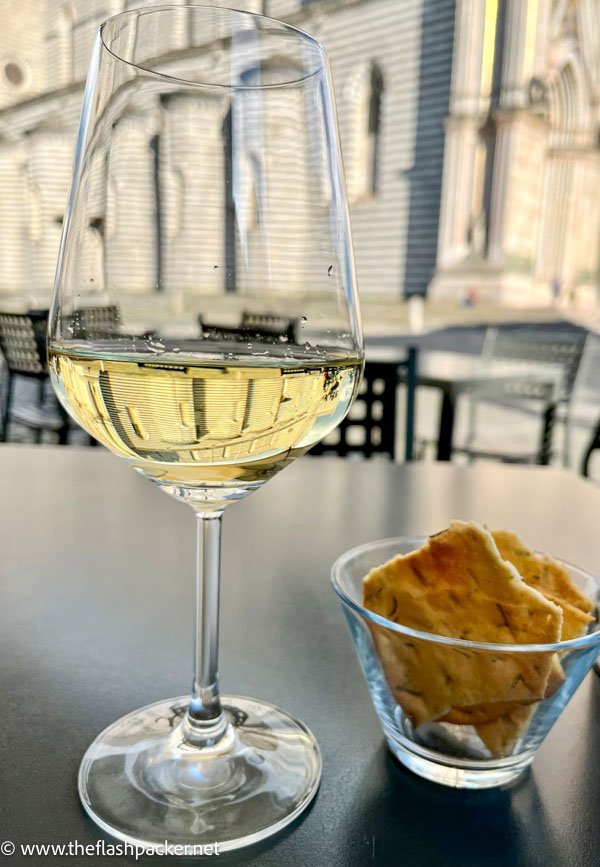
Cinque Terre day trip from Florence
This highly-rated day trip visits all five villages of the Cinque Terre National Park and includes optional lunch and a hike through coastal vineyards.
>>> CLICK HERE TO BOOK
Tuscany Day Trip with Optional Lunch and Wine
This is another cracker of a day trip from Florence, visiting Siena, San Gimignano and Pisa. Tasting of four Chianti region wines in a traditional wine estate is also on offer.
>>> CLICK HERE TO BOOK
Chianti wineries tour from Florence
If wine is more of your thing – it gets my vote – take a look at this affordable experience. There are visits to two vineyards and tasting up to five wines in each.
>>> CLICK HERE TO BOOK
Getting There
The local Peretola Airport (FLR) is six miles from Florence’s city centre.
A regular bus service will take you from Peretola airport to the city centre in just over ten minutes. Fixed-rate taxis are also available.
The bad news is that Peretola is not served by many airlines and fares tend to be on the high side. For many people, better alternatives are Pisa’s Galileo Galilei Airport (PSA) or even Rome Fiumicino (FCO) and Milan Malpensa (MXP).
From all of these airports, you can connect to the Italian rail system, which will bring you to Florence’s main Santa Maria Novella station.
If you are arriving in Florence by train, there are excellent rail connections to other major Italian cities, including Rome, Naples, Bologna, Milan, Venice and Turin. Services are operated by Trenitalia and Italo.
Getting Around
The best way to get around Florence is on foot.
Many of Florence’s most popular attractions lie on the north bank of the River Arno, within walking distance of the cathedral’s iconic dome. Everything is within a 20-minute walk from the cathedral, Santa Maria Novella train station or the Ponte Vecchio.
The only time that you might be tempted to jump on a bus is if you cannot face the uphill climb to Piazzale Michelangelo. Another way of getting to Piazzale Michelangelo is on an e-bike tour of Florence, which attracts great reviews.
For other fun-filled ways of getting around Florence, take a look at an eco tour by electric cart, a guided bike tour of the historical centre and a tour by electric scooter.
There’s even an electric bike tour at night with gelato tasting. That gets my vote.
Florence also has a hop-on-hop-off bus. Considering the compact nature of the historical centre, I can’t see how this will be of value unless you are planning to use it to take you to Fiesole.
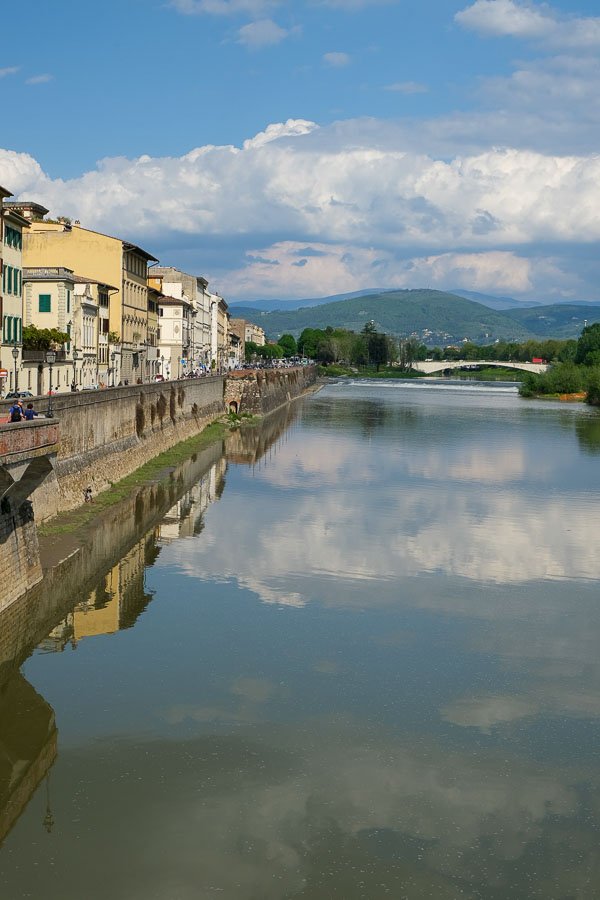
Where to stay in Florence
Where you stay in Florence will be determined by the personality of the area and your budget.
As this is one of the most expensive cities to stay in Tuscany, budget accommodation options in Florence are thin on the ground. It can be a struggle to find somewhere decent that isn’t a hostel for less than £100 a night.
Here are my recommendations for where to stay in Florence:
Luxury Hotel
If you’ve ever dreamt of having a room with a view, book a room at this 5-star hotel on the north side of the Arno River. The most expensive of Hotel Lungarno’s elegant rooms overlook the river.
>>> CLICK HERE TO CHECK PRICES & AVAILABILITY
Mid-range hotel
This modern 4-star hotel is just a few steps from the Church of San Lorenzo and a 5-minute walk from the train station. Keenly priced single rooms are available and reviews are very good.
>>> CLICK HERE TO CHECK PRICES & AVAILABILITY
Apartment
Sometimes you can make your travel budget stretch further by renting an apartment. This superb-looking apartment in the shadow of Santa Croce features a washing machine, and hot tub in which to soak those aching limbs after a busy day seeing the sights of your Florence itinerary.
>>> CLICK HERE TO CHECK PRICES & AVAILABILITY
Solo Travel in Florence
Italy is an excellent country for solo travellers, even if you are travelling alone for the first time. It has a long-established tourism infrastructure, a rich historical and cultural legacy and a well-beaten travel path.
Equally, Florence is a superb city if you are travelling alone.
Keeping safe is a priority amongst female solo travellers. Overall, Florence is a safe city I have never felt at risk, even walking its streets after dark on weekdays.
That said, a little bit of common sense goes a long way. Watch out for the nimble fingers of pickpockets, especially in popular tourist areas and transport hubs.
Remain vigilant and keep your belongings close to you. If you have a safe at your accommodation, use it to store valuables.
And That’s a Wrap!
I hope this guide helps you have an unforgettable weekend in Florence and that you love the city as much as I do. Before you leave, check out a few of my other guides to help plan your trip:
- The Perfect Solo Trip to Florence: Italy’s Renaissance Gem
- Where to Stay in Florence, Italy: The 7 Best Areas
- 20 Famous Statues & Sculptures in Florence
- 30 Paintings for Your Florence Art Bucket List
- 25 Famous Landmarks in Florence You’ll Adore

About Bridget
Bridget Coleman has been a passionate traveller for more than 30 years. She has visited 70+ countries, most as a solo traveller.
Articles on this site reflect her first-hand experiences.
To get in touch, email her at hello@theflashpacker.net or follow her on social media.

